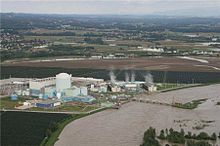Krško Nuclear Power Plant
| Krško Nuclear Power Plant | |
|---|---|
 |
|
| Country | Slovenia |
| Coordinates | 45°56′18″N 15°30′56″E / 45.93833°N 15.51556°ECoordinates: 45°56′18″N 15°30′56″E / 45.93833°N 15.51556°E |
| Construction began | 1975 |
| Commission date | January 1, 1983 |
| Operator(s) | Nuklearna Elektrarna Krško |
| Nuclear power station | |
| Reactor type | PWR |
| Power generation | |
| Units operational | 1 x 730 MW |
| Nameplate capacity | 730 MW |
| Capacity factor | 82.7% |
| Annual output | 5,289 GW·h |
|
Website http://www.nek.si/en/ |
|
The Krško Nuclear Power Plant (Slovene: Jedrska elektrarna Krško, JEK, or Nuklearna elektrarna Krško, NEK, Croatian: Nuklearna elektrana Krško) is located in Vrbina in the Municipality of Krško, Slovenia. The plant was connected to the power grid on October 2, 1981 and went into commercial operation on January 15, 1983. It was built as a joint venture by Slovenia and Croatia which were at the time both part of Yugoslavia.
The plant is a 2-loop Westinghouse pressurized water reactor, with a rated thermal capacity of 1,994 thermal megawatts (MWt) and 696 megawatts-electric (MWe). It runs on enriched uranium (up to 5 weight-percent 235U), fuel mass 48.7 t, with 121 fuel elements, demineralized water as the moderator, and 36 bundles of 20 control rods each made of silver, indium and cadmium alloys to regulate power. Its sister power plant is Angra I in Brazil.
The operating company Nuklearna elektrarna Krško (NEK) is co-owned by the Slovenian state-owned company Gen-Energija and the Croatian state-owned company Hrvatska elektroprivreda (HEP). The power plant provides more than one-quarter of Slovenia's and 15 percent of Croatia's power.
In the early 1970s, Tito's government of Yugoslavia recognized the need for additional electrical production in the constituent republics of Croatia and Slovenia. With a domestic source of uranium available, proposals were obtained from Siemens (Germany) and Westinghouse (USA) for a single nuclear power of a practical size. With the agreement of the U.S. government, Westinghouse won the competition to supply a plant based upon the Angra power plant being constructed in Brazil at that time. The Yugoslav management in 1975 consisted of personnel from both the Slovenian and Croatian power companies and a representative from the central government in Belgrade. As the design began, it was recognized that Westinghouse had a more modern design underway for the KORI-2 plant which is now the sister plant of Krsko. Indeed when the Krsko Plant began producing power in 1981, it preceded both the Angra and Kori-2 plants.
...
Wikipedia

